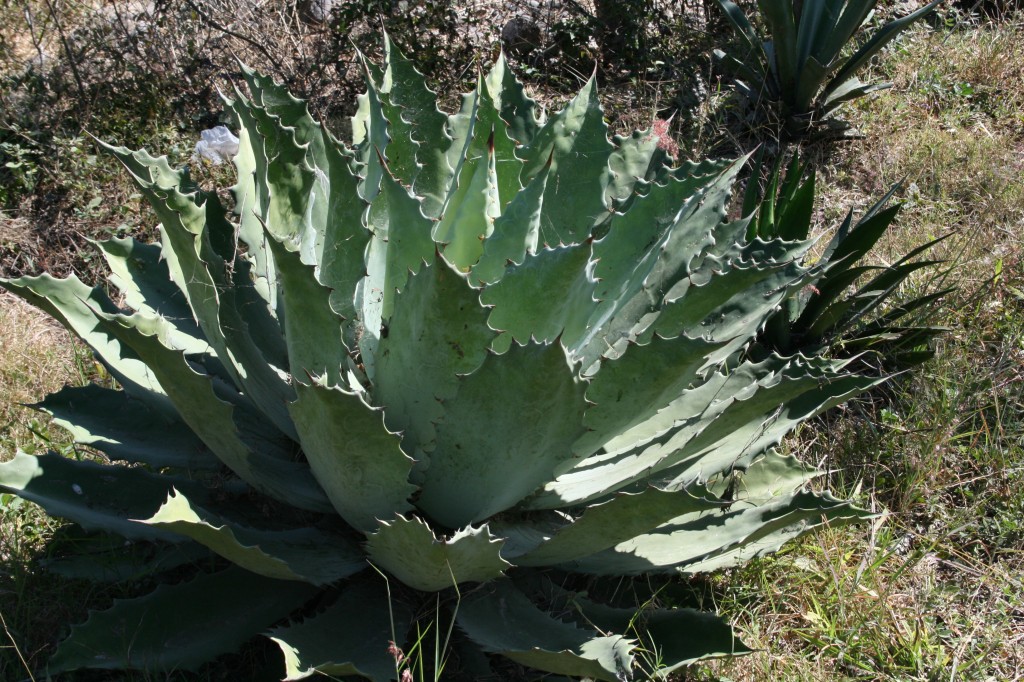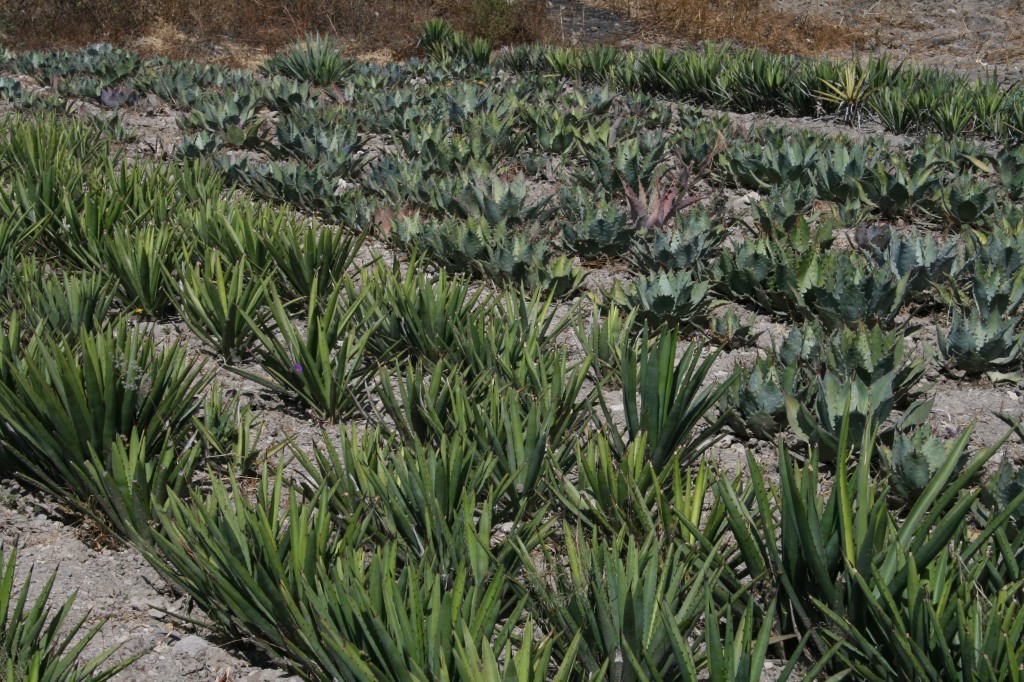I have been wanting to write this post for awhile as a follow up to my Zignum post, but have been slow to get to it. My friends at Mezcalistas recently put up an excellent piece that touches on many economic issues that need to be addressed by the multitude of stakeholders in the mezcal world. Continuing the sustainability theme, I want to highlight the few examples I know of where brands and producers are taking positive steps on the sustainability of the important natural resources that go into mezcal: primarily agave, wood and water.
The most significant issue is the sustainability of the agave population. As has been discussed by many, agaves take anywhere from eight to thirty years to reach maturity. Agave espadin, the predominant agave used to make mezcal, matures in eight to twelve years. Obviously, this is unlike other agricultural products used to make spirits which can be planted, grown and harvested within a year – think grapes, wheat, rye, barley, potatoes, and sugarcane to name a few.

Agave does not have it this good, and therein lies a large problem. Crop management is paramount. I will update this post if I hear from other brands about some of the things they may be doing around this theme of sustainability. Here are a few that I am aware of:
- Pierde Almas. In 2013, founder Jonathan Barbieri and a resolute group of about 20 others, planted over 1,000 baby tobalas in the mountains outside San Baltazar Chichicapan. This is a fantastic reforestation effort as tobalas are rare and do not produce much mezcal per plant as they are quite small even at maturity. I have heard it is an annual event, but I am not sure how many times they have done this so far. Jonathan?
- Agaves Silvestres (yes, “Agaves” is meant to be plural). This is a project started by the guys from Wahaka Mezcal. They purchased land in Oaxaca to start a nursery for madrecuixe and tobala. Then they partnered with the local schools to foster an “Adopt an Agave” program. Each child adopts an agave, replants it in the wild when the agave is 3-4 years old, then Wahaka pays market prices for the agaves at maturity. The funds go to buy books and supplies for the local schools. Great idea!
- El Buho. I had a long discussion with John Henry, passionate founder of the brand. He is deeply concerned with rumors that Oaxacan agave espadins are routinely transported out of Oaxaca to Jalisco for tequila production. If true, he feels stopping this is mission number one for today. The question is how do you stop it? There is no immediate answer. On the overall topic of sustainability, he views mezcal a bit like the wine business: each vintage has limited production and when you have no more agave, you stop. This focuses on estate grown agave and not the wide sourcing of agave from wherever you can get it. El Buho grows their own and does buy from other growers, but endeavors to build long-term relationships with any supplier they use and plan for appropriate crop management.
- Don Amado. They are one of the oldest brands around having in started in 1994, and their producer has been practicing and teaching agave management for years – including crop replacement, soil care and harvesting. Also, they have built a state-of-the-art water purification system to treat and recycle waste water from mezcal production. Finally, they only utilize “fallen” trees for their wood – no chopping down of live trees.
- El Jolgorio. They only work with small producers who use wild agaves. The producers will not harvest more than what is available and ready. As a result, El Jolgorio production will be relatively small per expression – they have eight unique varietals (see my prior post for more), and they are OK with that. So am I! Produce what you reasonably can and no more – good plan.

So that is my starter kit of what a handful of brands and producers are currently doing. I am certain than many others have projects or procedures in place to help the sustainability cause.
If you are a brand owner or producer and want to contribute to this list, please email me at john@mezcalphd.com. In the meantime, drink mezcal!!


Dear John,
We will love to share the efforts we are doing at Copita field, in oaxaca.
We did an incredible podcast with our friends from, Hey Hey Agave! (tuyo.nyc) and Lorena Terán Ibarra
https://tuyo.nyc/blogs/hey-hey-agave/27-lorena-terran-ibarra
Regenerative Agriculture in Oaxaca
Lorena Terán Ibarra is our director of Copita Project for El Buho Mezcal where she leads the regenerative agriculture and educational programs.
Initiated by the founders of El Buho, the Copita Project seeks to replenish and preserve the balance of the natural environment while planting cultivated and semi-cultivated agaves.
Practicing regenerative, organic agriculture in Copita Field is not a one size fits all solution. Lorena was quite candid in explaining the importance of learning from the environment and adapting to its needs. She makes a case for thoughtful and deliberate interventions and strategies. Methods that take time but ultimately produce the most beneficial long-term and positive environmental impact.
this is a lovely update from this 2014 post, Saludos and thank you for all the work you do.
Salucita
G
[…] also why it lacks character. Aside from the lack of character, the production methods do little to consider the sustainability of agave. All that said, tasting it did open me up to the notion that mezcal hasn’t got to be […]
Hi Everyone,
I noticed that i’s been a while since anyones last post, so I hope i hear back from someone. I’m hoping someone can help answer a couple of questions.
What is the minimum amount of land need to start an mezcal batch?.. 2 acres, 5 acres, 50 acres, 100 acres?
I inherited 2 acres of Mezcal plants which should be ready to harvest within the next year or two. If I was to try to harvest and distill the 2acres of agave, how much mescal would that actually yield? Any help would be greatly appreciated.
Thanks.
While it sounds exciting, I am the wrong person to ask! I wish I could help…..
I think any discussion of this subject also needs to include some of the very detailed information found in Ana G. Valenzuela-Zapata and Gary P. Nabhan’s book Tequila: A Natural and Cultural History. The authors discuss at length the effects of growing huge fields of Agave Weberi in a monoculture with added fertilizers, water and herbicides, just like any other cash crop and they wrote it over 10 years ago! Wild harvesting on steep mountainsides is very expensive, inefficient and ultimately a completely unsustainable practice but the alternative, assuming continued growth in demand also creates problems. For the consumer one problem is changes in Mezcal quality when the agave in question becomes a row cultivated cash crop grown on flat land with water and fertilizer added to greatly speed up time to maturity. Expect a big change in flavor when compared to the all wild harvested product grown under harsh low water conditions on steep hillsides. There is a reason that herbalists will pay extra for wild crafted herbs and spices and this applies to agave cultivation as well. Unfortunately for the agave, huge quantities are need to make the spirit we hold so dear.
Thanks for the comments. If you read my book, Holy Smoke! It’s Mezcal! (which by the way, I highly recommend), I talk a lot more about this issue, including references to the Ana’s book! Buy my book and I am sure you will be psyched to see that I agree with all you say!
Great job John. Thanks for bringing a wide picture of this.
It is great to have information from other projects towards this. Here at Los Danzantes, social impact and sustainability is part of our mission. All of our Alipus producers own fields and/or buy from family fields in order to support the local economy. And that’s why Alipus have been focused only on espadin mezcal as a regular product, and to use wild agaves only for limited editions (sorry, only available in Mexico right now). On the other hand we have been helping them also to start with nurseries for tobala plants, that this year will go to the mountains for reforestation.
Last year we promote a first attempt for an annual gathering towards agave sustainability. Encuentro Agave is a collaborative summit and had a good response on the first gathering last October, and set a wide view of what the scenario is. Encuentro Agave is planned to be repeated this year in October, and we’ll try to set the next stepping stone, to what eventually may become a Sustainable Agave certification, validated by the production chain. More information and preliminary results at http://www.huboaxaca.org/encuentroagave/ . It is open to anyone who wants to contribute or learn, and we’ll be sure that the guys mentioned here can join us.
This year we are also working with a University as an early experiment to micro-propagate 100 thousand plants from the most difficult to reproduce wild agaves, mainly from Agave Americana varieties.
We are very interested to get more involved and collaborate in any effort.
Sten
This is great stuff! Thanks to Sten and Los Danzantes for contributing.
Hi,
I, Douglas French, have been growing agave for 20 years. I started with espadin , but now I have 5 varietals growing on 50 acres. I stopped planting espadin about 10 years ago , I figure all the magueyeros plant espadin , so I don’t have to. Luckily I am still harvesting espadin , now that there is a shortage. Last year I planted 5,000 Barril ( also known as maderecuiche) . It takes 12 to 15 years to mature. This year I will plant 15,000 tobala , I usually plant 2,000 to 5,000 tobala a year.
Every year I plant and I harvest . In terms of mezcal production my crops are barely a drop in the bucket. It takes a lot of acres with lots of plant to amount to a hill of beans.
Check out our aficionado tasting box with 4 different varietals in 200 ml. bottles .
It has a bottle of espadin, barril, tequilana and tobala. Very cool.
Producers owning their own agave fields seems like a good path toward sustainability. Keep up the good work!
For Mezcal lovers in Oregon, some of the Vino de Mezcal expressions can be found at
Hyland Hills Liquor.
So interesting your post and also interesting the responses of people in the business.
Thanks for the mention of Fundación Agaves Silvestres’ reforestation projects, John. Another project we have going is our Vino de Mezcal series. This project tries to kill two birds with one stone — bring awareness to ultra small-batch mezcaleros using sustainable production methods and raise funds for the non-profit. We purchase these mezcales from around Mexico at fair price, import them to the US and sell them at select bars/restaurants throughout the US. They are currently available at these fine establishments:
Loló in SF
Tres in SF
Vintage Coctail Lounge in Portland
Xico in Portland
Mi Mero Mole in Portland
Multnomah Whisk{e}y Library in Portland
Hilltop Kitchen in Tacoma, WA
Barrio – Seattle, WA
Frontera Grill – Chicago, IL
Oyamel – Washington, DC
La Guelaguetza – Los Angeles, CA
Having just gotten back from a visit to mezcal vago in Oaxaca I can confirm that espadin is being transported to Jalisco for tequila production. On the way out of town we witnessed a 40 ton semi being filled with harvested immature agave (2-5 years old) and although the landowner could not confirm the final destination of the plants (as they were sold to a coyote at a ridiculously low price) he did now that they were headed north. As we near another shortage of agave in Jalisco the theft of plants and profits from the espadin fields of Oaxaca will be of utmost concern to the sustainability of artisanal mezcal.
Hi John,
Actually I’m involved in Vinos de Mezcal (VdM) project. We are selling very rare Agave Spirits all around US. The fonds are going to Fundación Agaves Silvestres. So, drink good Mezcal it’s also a great way to reforest 😉
Cheers!
Agree that it’s for a great cause. Do you know of any online sellers so my readers can find these bottles??
Hello John:
If you cultivate the agave, it could reach maturity in 5 – 5 1/2 years.
That is good if true. I have been told time and again that the fastest espadin gets there is about 8 years, and that it from people who do cultivate. But let me recheck with some contacts. Thanks for contributing!!
Really interesting post! Thank-you. I’ve often pondered it while sipping on my Mezcal and it stresses me out. Jonathan, please post this information because I am very interested in volunteering.
Muchas gracias,
Mariana Moreno
Gracias. It is clearly important to mezcal’s future. Thanks for reading.
Hola John,
Thank you for the acknowledgement. We have actually been quietly reforesting Tobalá for the past four years, but it didn’t occur to us to ask for volunteers until last May. Our annual, pre-rainy season plantings shall continue indefinitely – especially now that we can count on such generous support from the Mezcal-loving public (this is REALLY hard work in fairly rugged conditions). I’ll let you know when we begin taking names for the Tobalá-corpse 2014 roster!
Salud!
Jonathan Barbieri
Fantastic! Thank you for contributing and pursuing the reforestation project.